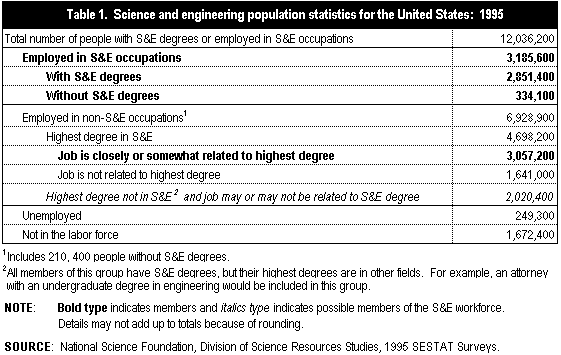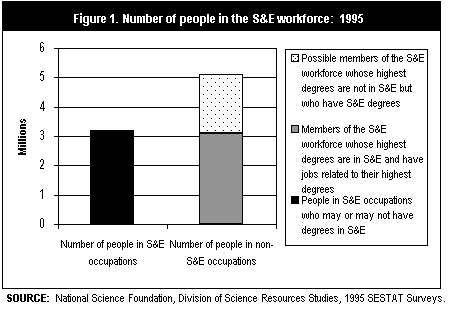
Directorate for Social, Behavioral
and Economic Sciences
NSF 99-344 May 3, 1999

Knowledge of science and/or engineering has become a prerequisite for a growing number of jobs.
Although they are not employed in traditional S&E occupations, some of these people use their S&E education on a regular basis in their jobs.
Determining the number of people working in science and engineering (S&E) is a highly complex issue. In addition to occupation, education also has a role in deciding who is counted - or not counted - as part of the S&E workforce.
The National Science Foundation (NSF) has identified five broad categories of S&E occupations - computer & mathematical scientists, life scientists, physical scientists, social scientists, and engineers.[1] These are considered to be traditional S&E occupations, and in 1995, approximately 3.2 million people held jobs classified in them.
In addition to those employed in traditional S&E occupations, there are other professionals who regularly use their education in science and/or engineering in their jobs. Among these are the chemist who teaches high school chemistry and the engineer who manages a manufacturing plant. Under the current occupational classification system, the chemist would be considered a teacher and the engineer a manager; neither would be counted as part of the S&E workforce.[2]
The chemistry teacher and the plant manager are obvious examples that illustrate that using a strict occupational definition underestimates the size of the S&E workforce. Less apparent are those in occupations truly beyond the traditional boundaries of science and engineering who nevertheless use their S&E education in their jobs. Examples in this group include the newspaper reporter who might not have been hired to write stories about science without having had a certain amount of education in science, and the patent attorney who may need S&E education to be able to litigate cases involving patent protection and infringement.[3] Because knowledge of science and/or engineering has become a prerequisite for a growing number of jobs, the S&E workforce could be considerably larger than the traditional count indicates.
Using a broader definition, the size of the S&E workforce stands at upwards of 6 million people, with a probable ceiling of no more than 8 million. As shown in table 1, this estimate is more than double the almost 3.2 million people employed in traditional science and engineering occupations in the United States, according to the most recent data (for 1995) from the National Science Foundation.[4]
In addition to the 3.2 million scientists and engineers, an estimated 3.1 million people reported that their jobs are closely or somewhat related to their highest degrees (in science and engineering).[5] Approximately one-third of these workers are classified as managers, and 11 percent as pre-college teachers.
Adding this second group to the first brings the size of the S&E workforce up to 6.3 million. Once again, everyone in this second category has his/her highest degree in an S&E field. This is an important distinction that separates the second group from a third, one whose members all have degrees in science or engineering, but whose highest degrees are in other, non-S&E fields (figure 1). Like the second group, members of the third category are not working in S&E occupations.
NSF does not, at this time, have information from members of this third group as to whether or not their jobs are closely or somewhat related to their S&E degrees. In fact, all that can be reported about them is their total number, just over 2 million in 1995. It is possible, however, that some of these people use their S&E education on a regular basis in their jobs. The patent attorney who has an undergraduate degree in engineering would fall into this category, as would the physician who has an undergraduate degree in biology. In fact, 37 percent of the people in this group have professional degrees, either in medicine, law, dentistry, veterinary science or some other field requiring advanced education, i.e., a professional degree, for licensure.
As shown in table 1, of the estimated 12 million people in the United States who either: a) have at least one degree in science and/or engineering, or b) do not have S&E degrees but are employed in S&E occupations, 6 to 8 million are current members of the S&E workforce. The others (4 to 6 million) either do not use their science and/or engineering education in their current (non-S&E) jobs, are unemployed, or are not in the labor force. Although some of these people may at some time in the future be working in science or engineering, at the current time, they are not members of the S&E workforce.
In the future, NSF should be able to provide a more precise count of the number of people who use their S&E education in their jobs on a regular basis but are not employed in traditional S&E occupations. Respondents to the 1999 National Survey of College Graduates whose highest degrees are not in S&E fields will be asked if their jobs require technical expertise in science and/or engineering. Data from this survey should be available early in the year 2000.
This Issue Brief was prepared by:
Melissa Pollak
Division of Science Resources Studies
National Science Foundation
4201 Wilson Boulevard, Suite 965
Arlington, VA 22230
703-306-1777 ext. 6931
E-mail: mpollak@nsf.gov
SRS data are available through the World Wide Web (http://www.nsf.gov/statistics/). For more information about obtaining reports, contact pubs@nsf.gov. or call (301) 947-2722. For NSF's Telephonic Device for the Deaf, dial (703) 306-0090. In your request, include the NSF publication number and title, your name, and a complete mailing address.

